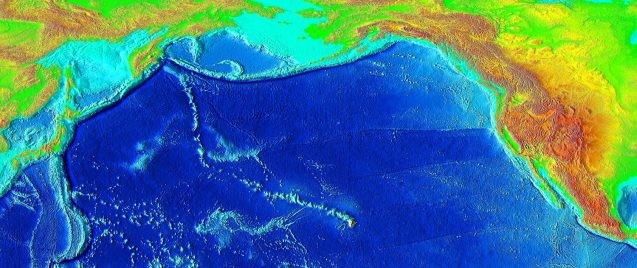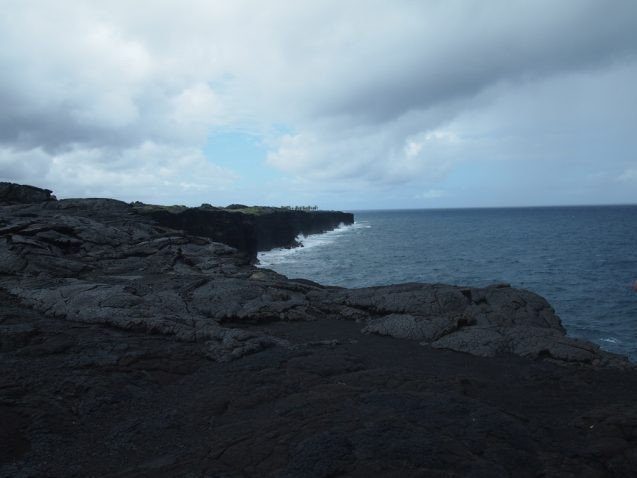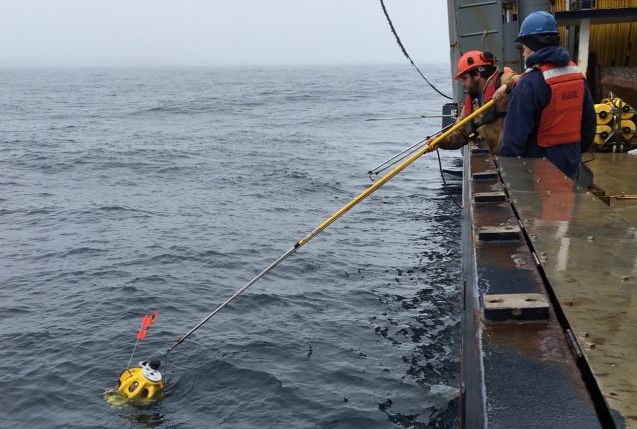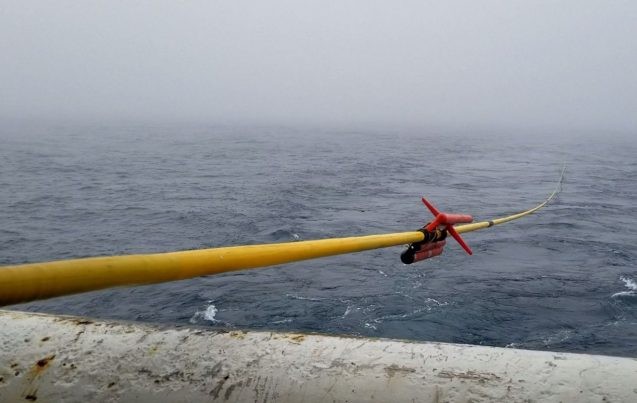Using Sound to Study Underwater Volcanoes
To find out how volcanoes in the Pacific Ocean influence earthquakes and tsunamis, a team of scientists listens for ‘echoes’ from under the sea.

Imagine placing a rock on a piece of suspended cardboard. If the cardboard is strong and hearty, like the cover of a hardback book, the rock can sit there for a long time and the board will barely flex due to the weight of the rock. But if the cardboard is flimsy, more like poster board, it will start to give beneath the weight of the rock, distorting in shape and structure.
Earth scientist Donna Shillington studies a similar concept when she studies the weight of hardening lava, or magma, on the earth’s surface. When volcanoes erupt, spouting fire, the lava cools over time and compounds, adding weight and stress that can cause Earth’s flimsier tectonic plates to bend and crack, which can create earthquakes, and in some cases, tsunamis.
Shillington wants to know exactly how much magma is hardened beneath a chain of volcanoes on the Pacific Plate, which lies beneath the Pacific Ocean. She’s also investigating how strong the plate is, and whether it will behave more like the cardboard or poster board under the weight of the rock — or in this case, magma.
Stretching 40 million square miles across the Earth’s surface, the Pacific Plate hovers over a hotspot, where very hot material from deep within the Earth plumes upward. As the plate has crept across this hotspot over the last tens of millions of years, the escaped heat interacting with the plate caused volcanic eruptions and created the Hawaiian-Emperor seamount chain, a mountain range that stretches 3,900 miles from the Aleutian Trench in the northwest Pacific to the Lo’ihi seamount just 22 miles southeast of the Island of Hawaii. Most of the chain is underwater — at least 80 underwater volcanoes have been identified — and the Hawaiian Islands are the only exposed peaks in the system.
As with any mountain system, scientists want to know what it’s made up of, how it formed, and how it’s changed over time. But, because the younger volcanoes in this chain are capable of erupting and producing earthquakes or tsunamis, scientists also want to know how the load that the chain has added to the Pacific Plate may influence natural disasters. More importantly, they want to know how strong the plate is by studying how it responds to the load of the gigantic volcanoes.
Unfortunately, the easy-to-sample above-sea-level Hawaiian Islands are just a small portion of the expansive chain and only part of the story. To get the answers they need, Shillington and her colleagues have to go much, much deeper — below the ocean floor.

During the 2018-19 academic year, when Shillington was a Lamont Research Professor at Columbia University’s Lamont-Doherty Earth Observatory, she led two research cruises to the Hawaiian-Emperor seamount chain: one to the young Hawaiian part of the chain, and the other to the older northern half, where volcanos are up to 80 million years old. She wanted to learn as much as she could about the underwater volcanoes — and the earth beneath them — to understand how the Pacific Plate is holding up under the weight of magma, and also, where that magma is exactly.
“Knowing the properties of that plate is important for understanding how it will respond,” said Shillington, who is now an associate professor at Northern Arizona University. “A plate’s strength is the fundamental thing that will control how it behaves. For example, the strength of the oceanic plate will dictate how it bends and gets pushed down beneath the continents at subduction zones — a place that creates earthquakes.”
Traveling with Shillington on the expedition were two other Lamont-Doherty scientists — Brian Boston, a postdoctoral research scientist and Will Fortin, an associate research scientist. The team of principal investigators also included one scientist from Oxford University, Tony Watts; three scientists from the University of Hawaii — Robert Dunn, Garrett Ito, Paul Wessel; two scientists from the US Geological Survey — Uri ten Brink and Nathan Miller; and one scientist from GEOMAR — Ingo Grevemeyer. Through a competitive application process, the team also invited graduate students from around the country to join the cruises, and the students blogged about the experience.

Twice, in October 2018 and again in April 2019, the team set sail on the R/V Marcus G. Langseth, a ship that is owned by the National Science Foundation and operated by Lamont-Doherty Earth Observatory. The vessel is special because it has technology aboard that allows scientists to create two- and three-dimensional maps of the earth’s structure miles below the seafloor.
It took nine days of sailing from the Hawaiian Islands to reach their sampling location on the Emperor Seamount Chain in the Pacific Ocean, said Fortin. It was, in simplest terms, in the middle of nowhere. The typical view from the starboard was simply fog.
However, the team was not there to look or touch, but to listen. Using the ship’s onboard seismic mapping technology, they would map the underwater topography by sending sound waves into the water and measuring how they echoed, a technique called seismic imaging.
“Seismology is essentially standing in a canyon and shouting ‘echo’ and then hearing ‘echo’ come back to you, but a lot more complicated and a lot quieter,” said Fortin. “When you hear ‘echo’ come back to you, if you record the wave form and pay really close attention, you can tell what type of rock it’s bouncing off of because the echo that comes back changes based on what it’s hitting. Whether you’re in a place with a sandstone canyon or there’s a granite boulder, you can get that information from how the echo sounds—how loud it is, and how it’s distorted.”
To measure the echo, the team dropped barrel-sized seismometers overboard, where they sank over three miles down to rest on the ocean floor and pick up measurements of pressure and ground motion. They also towed a nine-mile-long cable fitted with pressure sensors behind the ship.
Then, they shouted into the canyon. Using an arsenal of onboard air compressor guns, they fired air bubbles into the water. They listened — in real time — and recorded.
In addition to the echoes sensed in the water column by the boat streamers, “as we produced the seismic waves, the seismometers on the ocean floor recorded how waves propagate through the Earth’s crust,” said Boston.

Fortin is also studying the role that the mountain chain plays in circulating and mixing sea water. Understanding the topography of the chain and its material make-up will help him to find out, as will taking a close look at how the echoes move through the water column.
Recording and analyzing echoes in water — and especially cold water — can be quite tedious, said Fortin. While shale and sandstone reflect about 20 percent of the original sound, only about 0.05 percent of the energy of the original sound is reflected between different layers of water.
“Reflections within the water column are muffled and quieter, like an echo returned from a pillow rather than a canyon wall,” said Fortin. “That is to say, unless you had specialized equipment like a seismic ship or bat ears, you wouldn’t hear an echo from your pillow. These echoes are so quiet and it takes some finesse. I’m tweaking some of my computational methods in order to get at it.”
Lastly, the team also wants to know how much new magma is hardening underneath the volcanoes.
“Some magma makes it to the surface, where it erupts as lava flows,” said Shillington. “However, some of the magmas do not make it to the surface — instead, they cool down and crystallize into rocks below Earth’s surface.”
The team uses sound waves to determine the thickness, composition and spatial distribution of the magmas that crystallized and turned into rocks at depth and never made it to the surface.
One year later, the data is still being analyzed to create a complete picture of what lies beneath, and how it may have changed over time.
“We were lucky to be able to collect so much data, and this is just the beginning of all that we hope to discover in these data sets,” said Shillington. Due to the remote location, “no one will go back and collect data where we worked for many years.”
